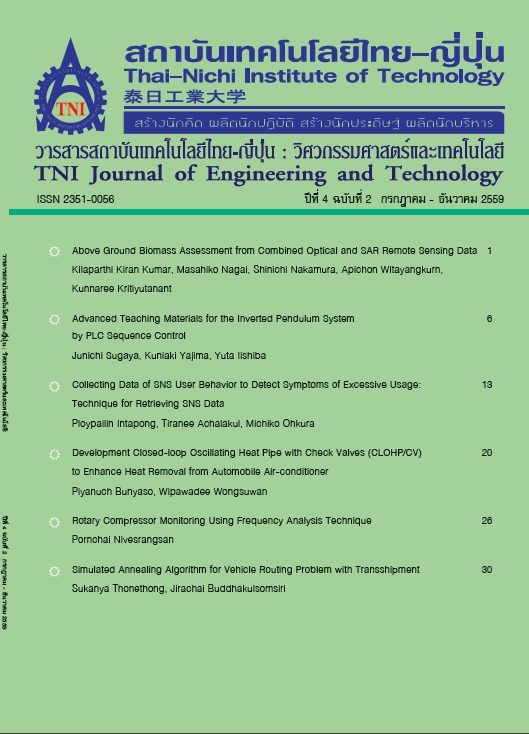Development Closed-loop Oscillating Heat Pipe with Check Valves (CLOHP/CV) to Enhance Heat Removal from Automobile Air-conditioner
Main Article Content
Abstract
The paper presented the application of the Closed-loop oscillating heat pipe with check valves (CLOHP/CV) to enhance heat extraction from the condenser of the automobile air-conditioner (AAC). The CLOHP/CV used R-134a as working fluid, filling 50% by volume. There were 3 designs having 4, 6 and 8 loops, and tested by varying tilted angle; 0º, 30º, 45º and 60º. The surface temperature of evaporator and condenser sections increased with the tilted angle and number of CLOHP/CV loops. The 8 loops CLOHP/CV tilted by 60 degrees provided maximum heat transfer rate 3,789 W, convection heat transfer coefficient 4,028 W/m2·ºC, and minimum thermal resistance 0.63 ºC/kW. The CLOHP/CV was tested with a demonstration unit of automobile air-conditioner at TNI. The COP and EER of the AAC using CLOHP/CV for enhancing heat removal from the condensing coil were 6.50 and 22.16 Btu/h/W, respectively. The maximum effectiveness of CLOHP/CV was nearly 0.5 when implementing to enhance heat releasing at AAC. Therefore, the 8-loops tilted by 60-degree CLOPH/CV was effectively enhancing performance of the automobile air-conditioner.
Article Details
Article Accepting Policy
The editorial board of Thai-Nichi Institute of Technology is pleased to receive articles from lecturers and experts in the fields of engineering and technology written in Thai or English. The academic work submitted for publication must not be published in any other publication before and must not be under consideration of other journal submissions. Therefore, those interested in participating in the dissemination of work and knowledge can submit their article to the editorial board for further submission to the screening committee to consider publishing in the journal. The articles that can be published include solely research articles. Interested persons can prepare their articles by reviewing recommendations for article authors.
Copyright infringement is solely the responsibility of the author(s) of the article. Articles that have been published must be screened and reviewed for quality from qualified experts approved by the editorial board.
The text that appears within each article published in this research journal is a personal opinion of each author, nothing related to Thai-Nichi Institute of Technology, and other faculty members in the institution in any way. Responsibilities and accuracy for the content of each article are owned by each author. If there is any mistake, each author will be responsible for his/her own article(s).
The editorial board reserves the right not to bring any content, views or comments of articles in the Journal of Thai-Nichi Institute of Technology to publish before receiving permission from the authorized author(s) in writing. The published work is the copyright of the Journal of Thai-Nichi Institute of Technology.
References
“Auto Air Conditioning Systems,” techniccar, 16-Jan-2014. [Online]. Available:https://www.techniccar.com/air- conditioning/. [Accessed: 04-Apr-2016].
R. Lumayos, C. Paprayoch, S. Chawpanit and P. Thasunton, Improve of COP of Split-Type Air-Conditioner by Installs Heat Pipe on Condensing Coil. Mashsarakham: Bureau of Vocational Education Research and Development, Mashsarakham Technical College, 2552.
P. Ratthasak, “A Study of Heat Cooling in Condenser of Air Conditioning System with Heat Pipe,” Master of Engineering Degree in Mechanical Engineering, Srinakharinwiroj University, Bangkok, 2008.
W. Suwan, M. Danai, Y. Pracha, P. Chainarong, and T. Pradit, “Application of Closed Loop Oscillating Heat Pipe to Increasing Performance of Turbo Charge Diesel Engine,” presented at the ME-NETT 18, Khon Kaen, 2004.
G. Burban, V. Ayel, A. Alexandre, P. Lagonotte, Y. Bertin, and C. Romestant, “Experimental investigation of a pulsating heat pipe for hybrid vehicle applications,” Applied Thermal Engineering, vol. 50, no. 1, pp. 94–103, Jan. 2013.
K. Sameer, “An Introduction to Pulsating Heat Pipes,” electronics-cooling, 01-May-2013. [Online]. Available: https:// www.electronics-cooling.com/2003/05/an-introduction-to-pulsating-heat-pipes/. [Accessed:04-Apr-2016].
“Vapor-Compression Refrigeration Cycle,” PTS. [Online]. Available:https://www.ptsservice.com/files/vaporcompression.pdf.
P. Charoensawan, P. Terdtoon, P. Tantakom, P. Ingsuwan, and M. Groll, “Effect of Inclination Angles, Filling Ratio and Total Lengths of Heat Transfer Characteristic of A Closed-Loop Oscillating Heat Pipe,” in 6th International Heat Pipe Symposium, Chiang Mai, Thailand, 2000, pp. 422–430.
S. Wasan and K. Den, “Enhancement of Heat Transfer Efficiency of Flat Two Phase Closed Thermosyphon by Using Copper Nano Powder with Water as Working Fluid,”Burapha Science Journal, vol. 18, no. 1, pp. 125–136, 2013.


